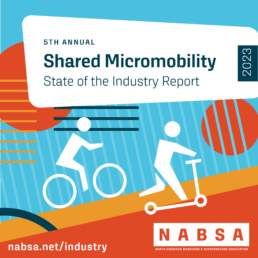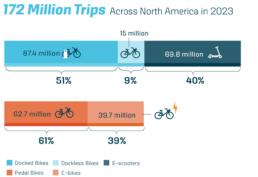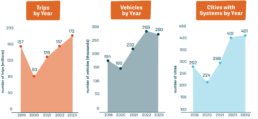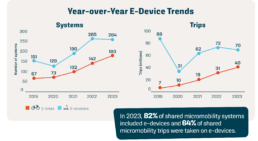NABSA’s Fifth Annual Shared Micromobility Report Shows an Industry at An All-time High
Shared Micromobility is growing, maturing, electrifying and gaining efficiencies and effectiveness

- Today, NABSA releases the fifth annual Shared Micrombility State of the Industry Report for North America – the only report of its kind tracking the trends, growth, and success of shared micromobility across North America.
- Shared micromobility ridership reaches a new high with at least 172 million trips taken across North America in 2023.
- 64% of shared micromobility trips were on electric devices.
- Number of cities across North America with shared micromobility in 2023 hits an all-time high with 421 cities for some or all of the year.
- Shared micromobility offset approximately 81 million pounds of CO₂ emissions (35 million kg) by replacing auto trips across North America in 2023.
August 6, 2024 – Today, the North American Bikeshare and Scootershare Association (NABSA), the nonprofit membership-based association representing public, private, and nonprofit organizations in shared micromobility, celebrates the release of the fifth annual Shared Micromobility State of the Industry Report for North America.
Being the fifth annual edition of the report– tracking trends before, during, and after the COVID-19 pandemic– the 2023 State of the Industry Report demonstrates shared micromobility’s continued viability and strength as an important mode in the public transportation ecosystem, and shows an industry that continues to grow, mature, electrify, and gain efficiencies and effectiveness. Shared micromobility ridership across North America as well as the number of cities with systems reached its highest annual level to date. In 2023, at least 172 million shared micromobility trips were taken in 421 cities across North America.


“There’s just no two ways about it, shared micromobility consistently delivers, year-over-year-over-year” said NABSA Executive Director Sam Herr. “Communities increasingly view and utilize shared micromobility as an essential mode in a multi-modal network. This is what we need to further climate and equity goals, and make our communities more sustainable into the future.”

Total shared micromobility vehicles deployed across North America decreased slightly in 2023 while the number of trips continued to rise, meaning that fleets generally had more rides per vehicle per service day. This higher utilization points to more fleet effectiveness and efficiency. New this year, the report captures how operators are electrifying and incorporating climate-friendly practices into shared micromobility operations. Sixty-seven percent of operators use e-bikes and 46% use EVs or hybrid vehicles to rebalance their shared micromobility fleets.
Shared micromobility continues to be a solution toward transportation decarbonization. In 2023, shared micromobility across North America offset approximately 81 million pounds of CO₂ emissions (37 million kg) by replacing car trips– 303 million lbs of CO₂ emissions (137 million kg) since 2019– and 37% of all shared micromobility trips continue to replace car trips.

The popularity and use of electric shared micromobility continues to trend remarkably upward. Sixty-four percent of shared micromobility rides in 2023 were taken on an e-device, and 82% of systems across North America incorporate electric shared micromobility devices. E-bikeshare trips continue to increase over time, from 7 million in 2019 to almost 40 million in 2023.

Shared micromobility continues to support transit with first/last mile service and make transportation more equitable. Seventy percent of riders report that they used shared micromobility to connect to transit, and 20% say they use it weekly to connect to transit. Ninety percent of shared micromobility systems offer discount programs, and 31% offer adaptive vehicles. In these ways, shared micromobility continues to be an integral part of transportation networks, increasing mode choice, transportation equity and sustainability, and helping to ensure that people get to where they need to go.
Over the last fifteen years as shared micromobility has turned the corner from proof-of-concept to integral transportation service, the cross-sector industry of shared micromobility is turning an eye toward financial sustainability. In recent years, public agencies across North America are starting and increasing their direct financial investment in shared micromobility services. New this year, the report captures a snapshot of this emerging support, as well as other financial expenses and operating characteristics.
“We’re at an all-hands-on-deck moment in shared micromobility. Support at state, provincial, and federal levels are needed to join in this effort,” says Herr.
NABSA’s fifth annual Shared Micromobility State of the Industry Report continues to demonstrate the strength, evolution, and benefits of shared micromobility in communities across North America, and confirms shared micromobility as an essential part of multi-modal mobility strategies that are necessary to get people where they need to go now and into the future.
NABSA worked with Toole Design and the University of California Berkeley Transportation Sustainability Research Center to help develop the report. The report is composed of survey results, statistics gathered from performance reports released by shared micromobility systems, and data from GBFS. In addition to the metrics shared above, more information about year-over-year trends, mode shift, benefits of shared micromobility, equity programs, trip and vehicle trends, system statistics by size, operating characteristics, shared micromobility and transit, and more can be found in the report.
Both an English and Spanish version of the report is available for download at nabsa.net/industry.
In addition to the annual Shared Micromobility State of the Industry Report, NABSA convenes an Annual Conference. The NABSA Annual Conference is the only shared micromobility-focused conference globally, and brings together shared mobility leaders, practitioners, operators, and equipment and technology providers to actively shape the future of shared micromobility. This year’s conference will be held October 7-9 in Philadelphia, Pennsylvania. More information about the conference and registration can be found at nabsa.net/2024conference/.
The North American Bikeshare & Scootershare Association (NABSA) collaborates across sectors to grow shared micromobility and its benefits to communities, creating a more equitable and sustainable transportation ecosystem. NABSA is the industry’s membership organization with representation from system owners, operators, host cities, equipment manufacturers, and technology providers. Learn more at nabsa.net.
